International Business: HRM Practices in Japan and Labor Welfare
VerifiedAdded on 2020/03/16
|7
|1510
|116
Report
AI Summary
This literature review explores the relationship between Human Resource Management (HRM) practices in Japan and labor welfare, emphasizing the importance of industrial peace for productivity. It examines how Japan has adopted HRM practices from other countries, focusing on harmonizing employment security with productivity and flexibility. The review highlights the impact of business reforms, economic factors, and government policies on HRM. It also discusses the shift in HR systems towards talent management and the effects of HRM practices on labor welfare, including gender equality and job satisfaction. Furthermore, it analyzes the impact of globalization and automation on the labor market, concluding with a discussion of existing literature gaps, particularly regarding the HRM paradigm.
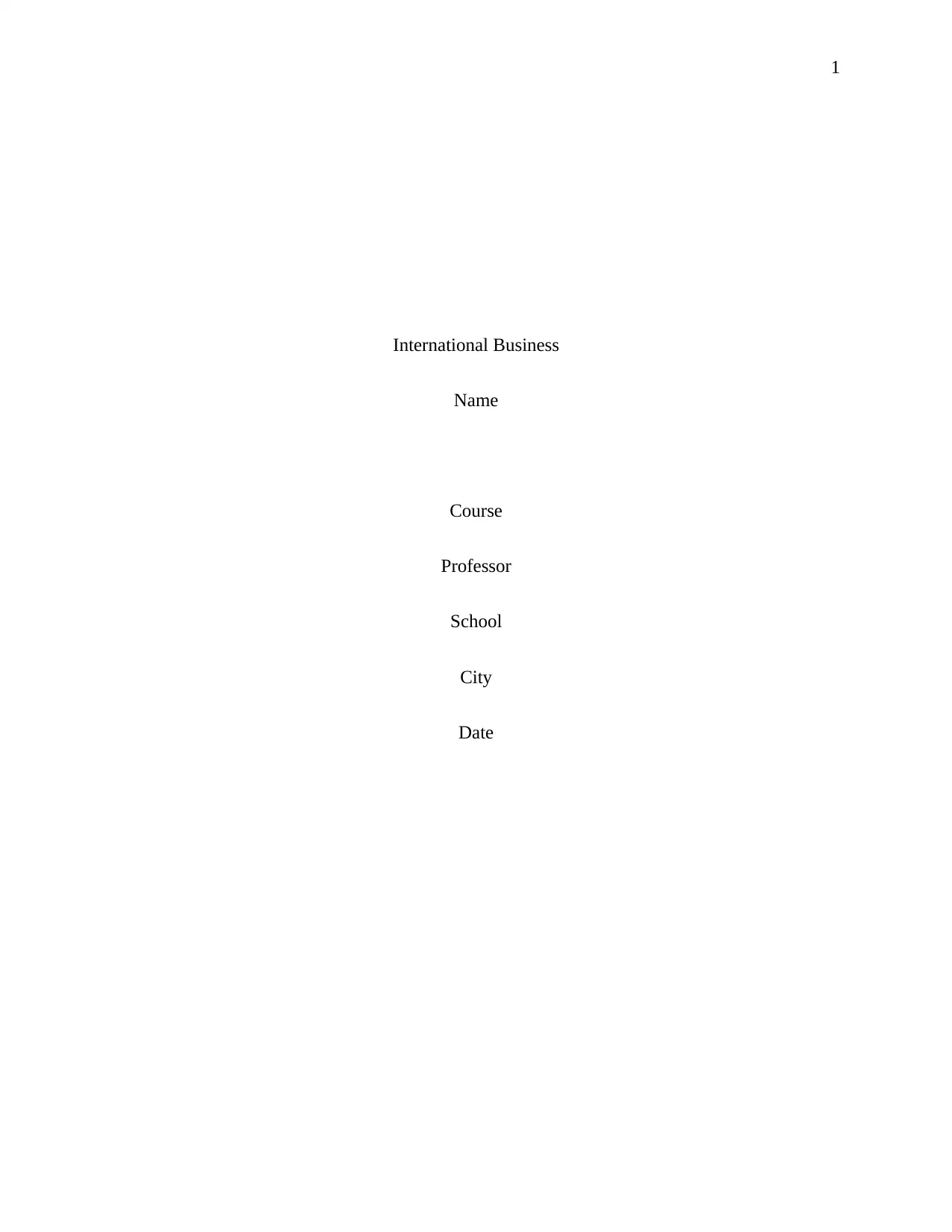
1
International Business
Name
Course
Professor
School
City
Date
International Business
Name
Course
Professor
School
City
Date
Paraphrase This Document
Need a fresh take? Get an instant paraphrase of this document with our AI Paraphraser
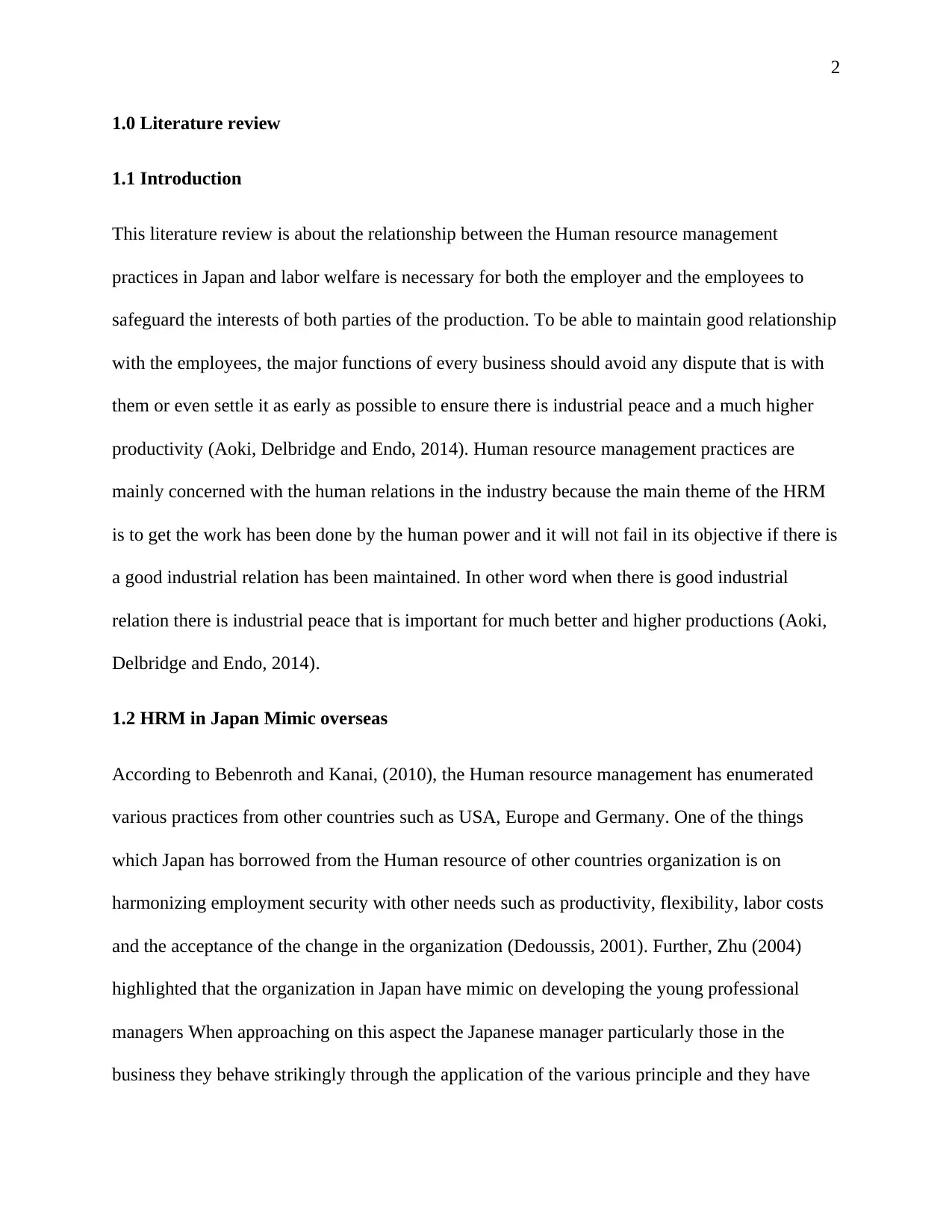
2
1.0 Literature review
1.1 Introduction
This literature review is about the relationship between the Human resource management
practices in Japan and labor welfare is necessary for both the employer and the employees to
safeguard the interests of both parties of the production. To be able to maintain good relationship
with the employees, the major functions of every business should avoid any dispute that is with
them or even settle it as early as possible to ensure there is industrial peace and a much higher
productivity (Aoki, Delbridge and Endo, 2014). Human resource management practices are
mainly concerned with the human relations in the industry because the main theme of the HRM
is to get the work has been done by the human power and it will not fail in its objective if there is
a good industrial relation has been maintained. In other word when there is good industrial
relation there is industrial peace that is important for much better and higher productions (Aoki,
Delbridge and Endo, 2014).
1.2 HRM in Japan Mimic overseas
According to Bebenroth and Kanai, (2010), the Human resource management has enumerated
various practices from other countries such as USA, Europe and Germany. One of the things
which Japan has borrowed from the Human resource of other countries organization is on
harmonizing employment security with other needs such as productivity, flexibility, labor costs
and the acceptance of the change in the organization (Dedoussis, 2001). Further, Zhu (2004)
highlighted that the organization in Japan have mimic on developing the young professional
managers When approaching on this aspect the Japanese manager particularly those in the
business they behave strikingly through the application of the various principle and they have
1.0 Literature review
1.1 Introduction
This literature review is about the relationship between the Human resource management
practices in Japan and labor welfare is necessary for both the employer and the employees to
safeguard the interests of both parties of the production. To be able to maintain good relationship
with the employees, the major functions of every business should avoid any dispute that is with
them or even settle it as early as possible to ensure there is industrial peace and a much higher
productivity (Aoki, Delbridge and Endo, 2014). Human resource management practices are
mainly concerned with the human relations in the industry because the main theme of the HRM
is to get the work has been done by the human power and it will not fail in its objective if there is
a good industrial relation has been maintained. In other word when there is good industrial
relation there is industrial peace that is important for much better and higher productions (Aoki,
Delbridge and Endo, 2014).
1.2 HRM in Japan Mimic overseas
According to Bebenroth and Kanai, (2010), the Human resource management has enumerated
various practices from other countries such as USA, Europe and Germany. One of the things
which Japan has borrowed from the Human resource of other countries organization is on
harmonizing employment security with other needs such as productivity, flexibility, labor costs
and the acceptance of the change in the organization (Dedoussis, 2001). Further, Zhu (2004)
highlighted that the organization in Japan have mimic on developing the young professional
managers When approaching on this aspect the Japanese manager particularly those in the
business they behave strikingly through the application of the various principle and they have
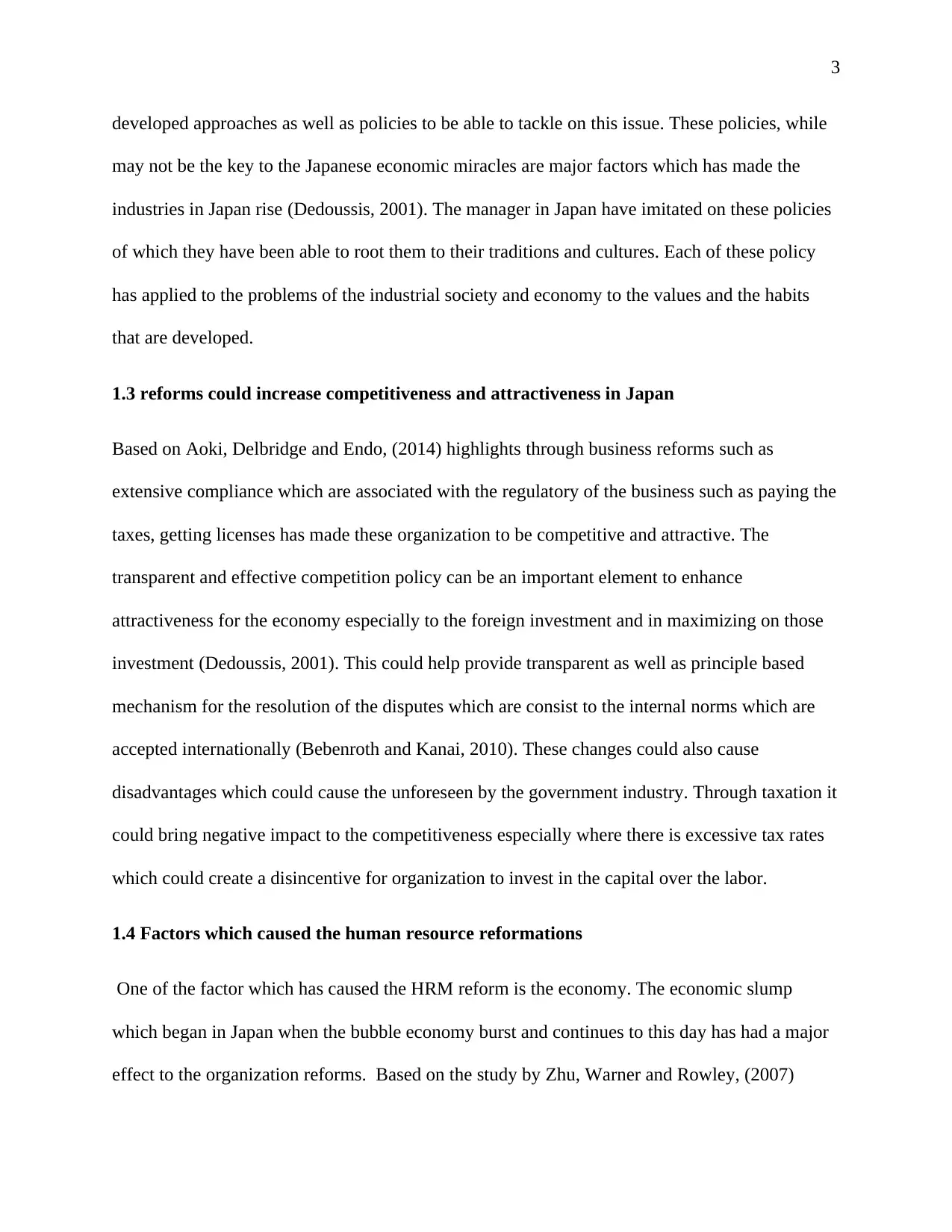
3
developed approaches as well as policies to be able to tackle on this issue. These policies, while
may not be the key to the Japanese economic miracles are major factors which has made the
industries in Japan rise (Dedoussis, 2001). The manager in Japan have imitated on these policies
of which they have been able to root them to their traditions and cultures. Each of these policy
has applied to the problems of the industrial society and economy to the values and the habits
that are developed.
1.3 reforms could increase competitiveness and attractiveness in Japan
Based on Aoki, Delbridge and Endo, (2014) highlights through business reforms such as
extensive compliance which are associated with the regulatory of the business such as paying the
taxes, getting licenses has made these organization to be competitive and attractive. The
transparent and effective competition policy can be an important element to enhance
attractiveness for the economy especially to the foreign investment and in maximizing on those
investment (Dedoussis, 2001). This could help provide transparent as well as principle based
mechanism for the resolution of the disputes which are consist to the internal norms which are
accepted internationally (Bebenroth and Kanai, 2010). These changes could also cause
disadvantages which could cause the unforeseen by the government industry. Through taxation it
could bring negative impact to the competitiveness especially where there is excessive tax rates
which could create a disincentive for organization to invest in the capital over the labor.
1.4 Factors which caused the human resource reformations
One of the factor which has caused the HRM reform is the economy. The economic slump
which began in Japan when the bubble economy burst and continues to this day has had a major
effect to the organization reforms. Based on the study by Zhu, Warner and Rowley, (2007)
developed approaches as well as policies to be able to tackle on this issue. These policies, while
may not be the key to the Japanese economic miracles are major factors which has made the
industries in Japan rise (Dedoussis, 2001). The manager in Japan have imitated on these policies
of which they have been able to root them to their traditions and cultures. Each of these policy
has applied to the problems of the industrial society and economy to the values and the habits
that are developed.
1.3 reforms could increase competitiveness and attractiveness in Japan
Based on Aoki, Delbridge and Endo, (2014) highlights through business reforms such as
extensive compliance which are associated with the regulatory of the business such as paying the
taxes, getting licenses has made these organization to be competitive and attractive. The
transparent and effective competition policy can be an important element to enhance
attractiveness for the economy especially to the foreign investment and in maximizing on those
investment (Dedoussis, 2001). This could help provide transparent as well as principle based
mechanism for the resolution of the disputes which are consist to the internal norms which are
accepted internationally (Bebenroth and Kanai, 2010). These changes could also cause
disadvantages which could cause the unforeseen by the government industry. Through taxation it
could bring negative impact to the competitiveness especially where there is excessive tax rates
which could create a disincentive for organization to invest in the capital over the labor.
1.4 Factors which caused the human resource reformations
One of the factor which has caused the HRM reform is the economy. The economic slump
which began in Japan when the bubble economy burst and continues to this day has had a major
effect to the organization reforms. Based on the study by Zhu, Warner and Rowley, (2007)
⊘ This is a preview!⊘
Do you want full access?
Subscribe today to unlock all pages.

Trusted by 1+ million students worldwide
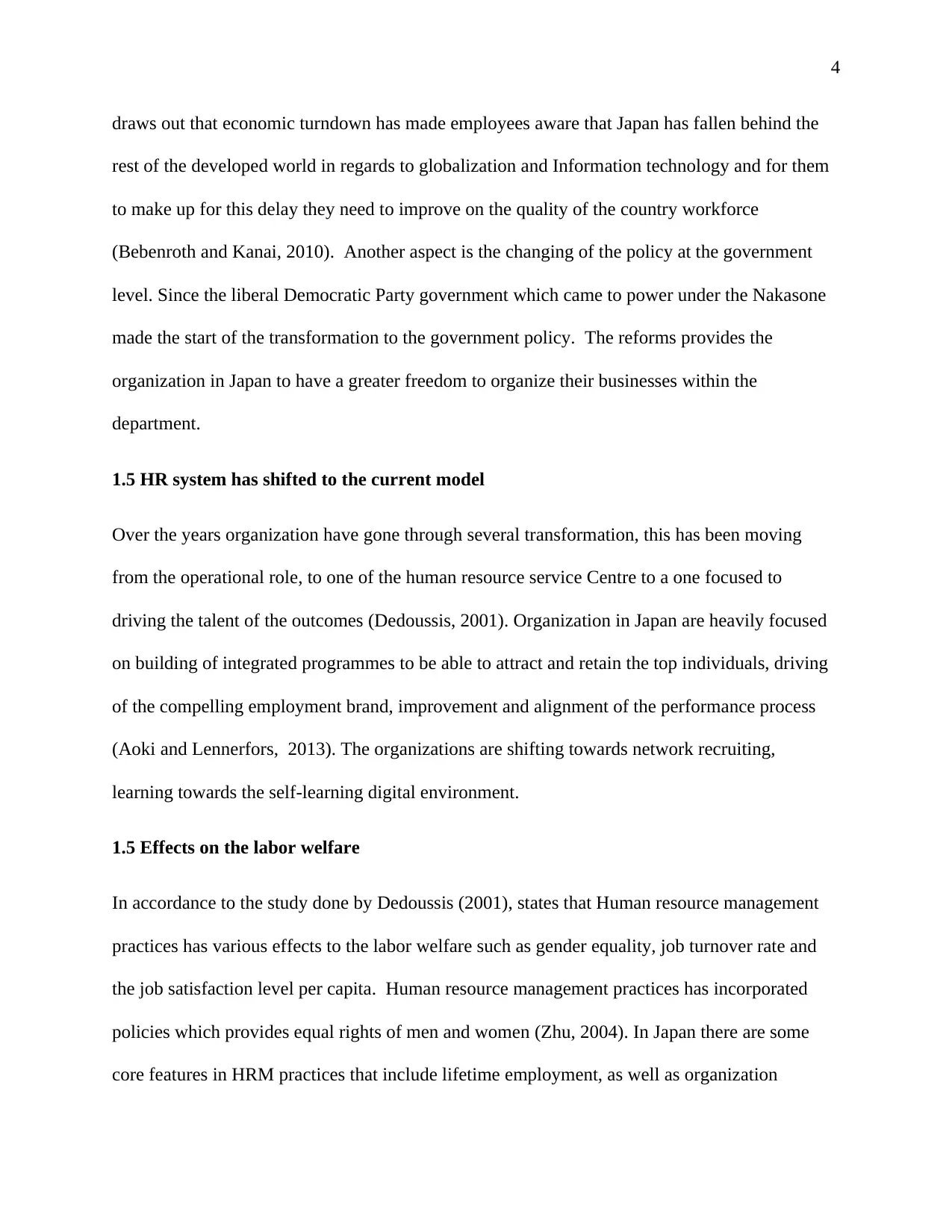
4
draws out that economic turndown has made employees aware that Japan has fallen behind the
rest of the developed world in regards to globalization and Information technology and for them
to make up for this delay they need to improve on the quality of the country workforce
(Bebenroth and Kanai, 2010). Another aspect is the changing of the policy at the government
level. Since the liberal Democratic Party government which came to power under the Nakasone
made the start of the transformation to the government policy. The reforms provides the
organization in Japan to have a greater freedom to organize their businesses within the
department.
1.5 HR system has shifted to the current model
Over the years organization have gone through several transformation, this has been moving
from the operational role, to one of the human resource service Centre to a one focused to
driving the talent of the outcomes (Dedoussis, 2001). Organization in Japan are heavily focused
on building of integrated programmes to be able to attract and retain the top individuals, driving
of the compelling employment brand, improvement and alignment of the performance process
(Aoki and Lennerfors, 2013). The organizations are shifting towards network recruiting,
learning towards the self-learning digital environment.
1.5 Effects on the labor welfare
In accordance to the study done by Dedoussis (2001), states that Human resource management
practices has various effects to the labor welfare such as gender equality, job turnover rate and
the job satisfaction level per capita. Human resource management practices has incorporated
policies which provides equal rights of men and women (Zhu, 2004). In Japan there are some
core features in HRM practices that include lifetime employment, as well as organization
draws out that economic turndown has made employees aware that Japan has fallen behind the
rest of the developed world in regards to globalization and Information technology and for them
to make up for this delay they need to improve on the quality of the country workforce
(Bebenroth and Kanai, 2010). Another aspect is the changing of the policy at the government
level. Since the liberal Democratic Party government which came to power under the Nakasone
made the start of the transformation to the government policy. The reforms provides the
organization in Japan to have a greater freedom to organize their businesses within the
department.
1.5 HR system has shifted to the current model
Over the years organization have gone through several transformation, this has been moving
from the operational role, to one of the human resource service Centre to a one focused to
driving the talent of the outcomes (Dedoussis, 2001). Organization in Japan are heavily focused
on building of integrated programmes to be able to attract and retain the top individuals, driving
of the compelling employment brand, improvement and alignment of the performance process
(Aoki and Lennerfors, 2013). The organizations are shifting towards network recruiting,
learning towards the self-learning digital environment.
1.5 Effects on the labor welfare
In accordance to the study done by Dedoussis (2001), states that Human resource management
practices has various effects to the labor welfare such as gender equality, job turnover rate and
the job satisfaction level per capita. Human resource management practices has incorporated
policies which provides equal rights of men and women (Zhu, 2004). In Japan there are some
core features in HRM practices that include lifetime employment, as well as organization
Paraphrase This Document
Need a fresh take? Get an instant paraphrase of this document with our AI Paraphraser
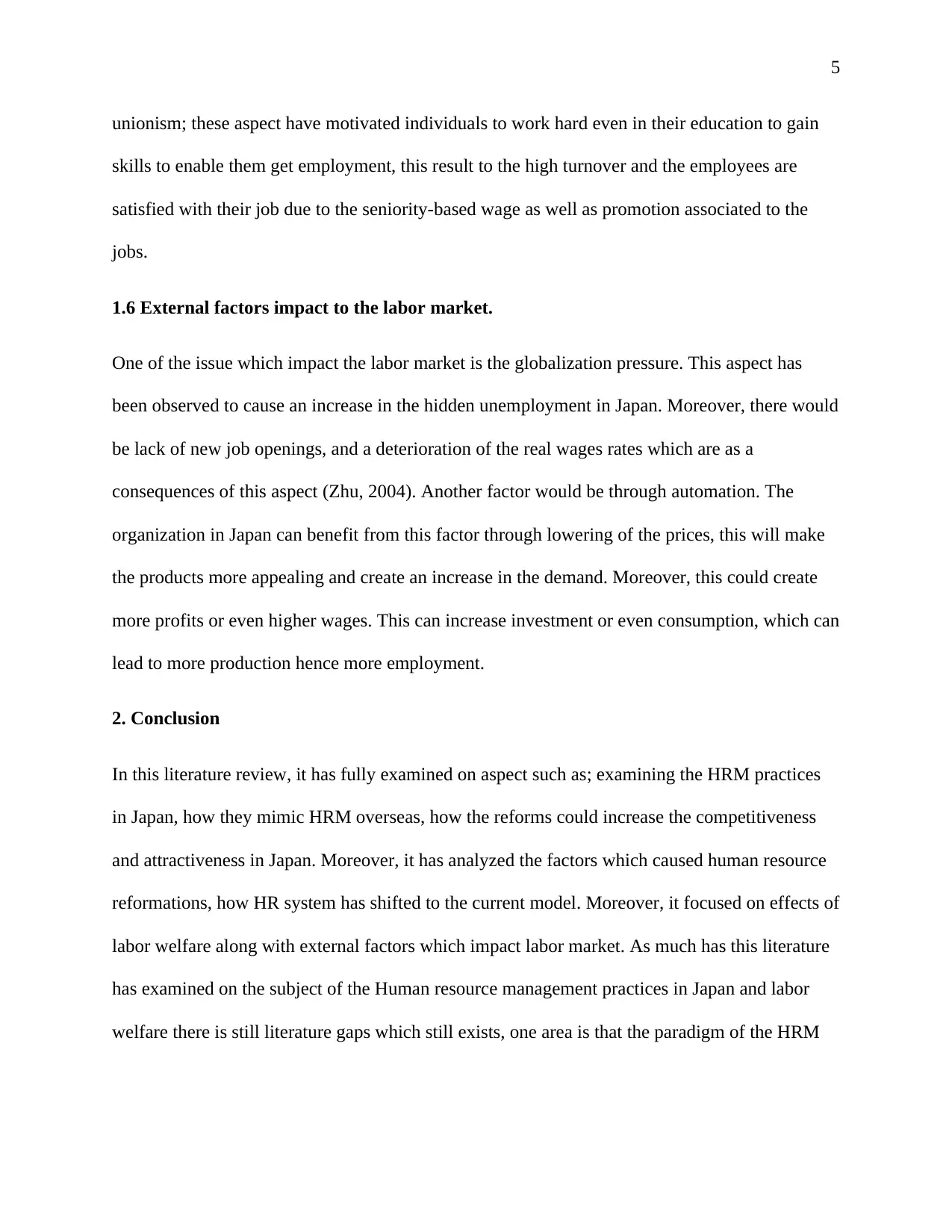
5
unionism; these aspect have motivated individuals to work hard even in their education to gain
skills to enable them get employment, this result to the high turnover and the employees are
satisfied with their job due to the seniority-based wage as well as promotion associated to the
jobs.
1.6 External factors impact to the labor market.
One of the issue which impact the labor market is the globalization pressure. This aspect has
been observed to cause an increase in the hidden unemployment in Japan. Moreover, there would
be lack of new job openings, and a deterioration of the real wages rates which are as a
consequences of this aspect (Zhu, 2004). Another factor would be through automation. The
organization in Japan can benefit from this factor through lowering of the prices, this will make
the products more appealing and create an increase in the demand. Moreover, this could create
more profits or even higher wages. This can increase investment or even consumption, which can
lead to more production hence more employment.
2. Conclusion
In this literature review, it has fully examined on aspect such as; examining the HRM practices
in Japan, how they mimic HRM overseas, how the reforms could increase the competitiveness
and attractiveness in Japan. Moreover, it has analyzed the factors which caused human resource
reformations, how HR system has shifted to the current model. Moreover, it focused on effects of
labor welfare along with external factors which impact labor market. As much has this literature
has examined on the subject of the Human resource management practices in Japan and labor
welfare there is still literature gaps which still exists, one area is that the paradigm of the HRM
unionism; these aspect have motivated individuals to work hard even in their education to gain
skills to enable them get employment, this result to the high turnover and the employees are
satisfied with their job due to the seniority-based wage as well as promotion associated to the
jobs.
1.6 External factors impact to the labor market.
One of the issue which impact the labor market is the globalization pressure. This aspect has
been observed to cause an increase in the hidden unemployment in Japan. Moreover, there would
be lack of new job openings, and a deterioration of the real wages rates which are as a
consequences of this aspect (Zhu, 2004). Another factor would be through automation. The
organization in Japan can benefit from this factor through lowering of the prices, this will make
the products more appealing and create an increase in the demand. Moreover, this could create
more profits or even higher wages. This can increase investment or even consumption, which can
lead to more production hence more employment.
2. Conclusion
In this literature review, it has fully examined on aspect such as; examining the HRM practices
in Japan, how they mimic HRM overseas, how the reforms could increase the competitiveness
and attractiveness in Japan. Moreover, it has analyzed the factors which caused human resource
reformations, how HR system has shifted to the current model. Moreover, it focused on effects of
labor welfare along with external factors which impact labor market. As much has this literature
has examined on the subject of the Human resource management practices in Japan and labor
welfare there is still literature gaps which still exists, one area is that the paradigm of the HRM

6
has not been fully addressed. It does not shows how Japan has been adopted on some of the
practices to the other countries and what those countries have also borrowed.
has not been fully addressed. It does not shows how Japan has been adopted on some of the
practices to the other countries and what those countries have also borrowed.
⊘ This is a preview!⊘
Do you want full access?
Subscribe today to unlock all pages.

Trusted by 1+ million students worldwide
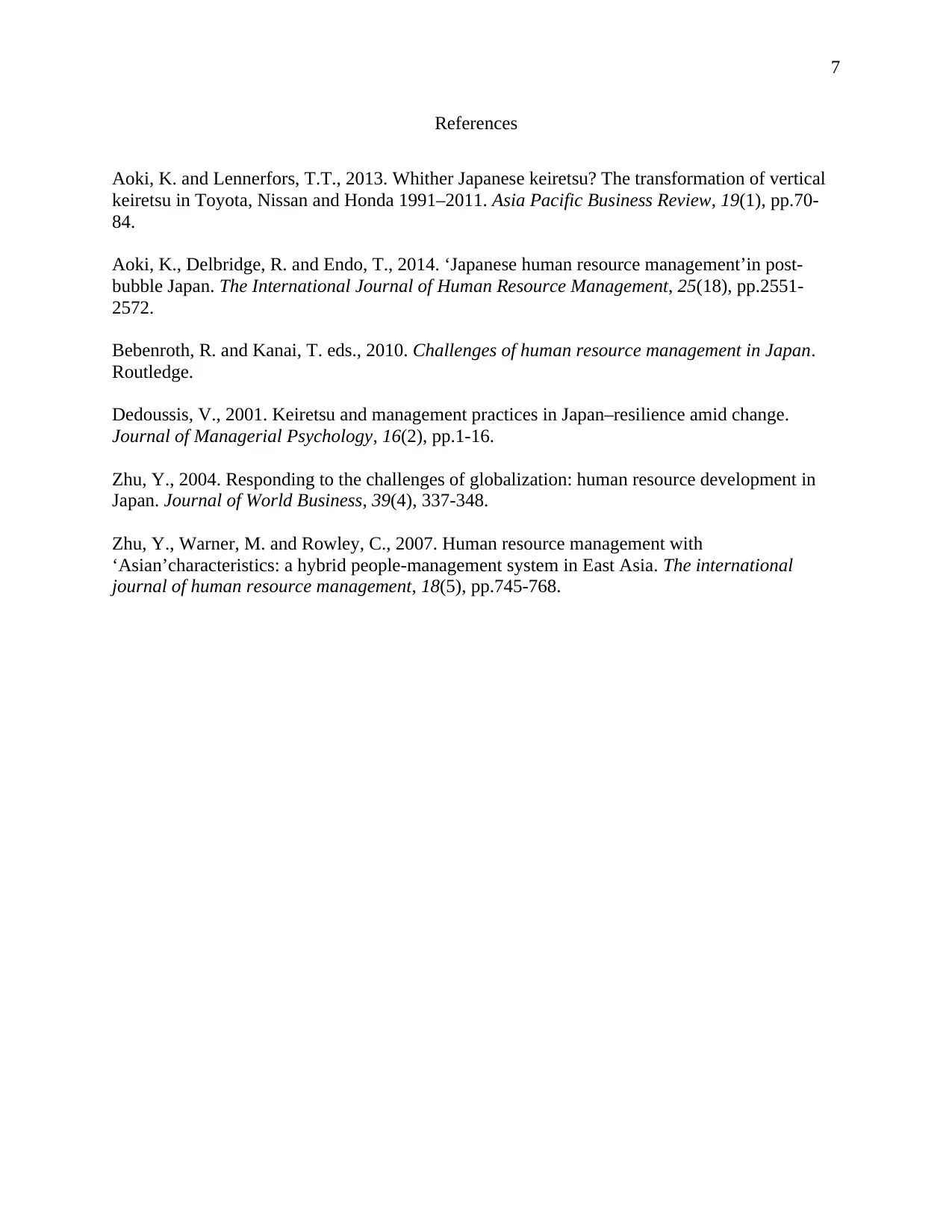
7
References
Aoki, K. and Lennerfors, T.T., 2013. Whither Japanese keiretsu? The transformation of vertical
keiretsu in Toyota, Nissan and Honda 1991–2011. Asia Pacific Business Review, 19(1), pp.70-
84.
Aoki, K., Delbridge, R. and Endo, T., 2014. ‘Japanese human resource management’in post-
bubble Japan. The International Journal of Human Resource Management, 25(18), pp.2551-
2572.
Bebenroth, R. and Kanai, T. eds., 2010. Challenges of human resource management in Japan.
Routledge.
Dedoussis, V., 2001. Keiretsu and management practices in Japan–resilience amid change.
Journal of Managerial Psychology, 16(2), pp.1-16.
Zhu, Y., 2004. Responding to the challenges of globalization: human resource development in
Japan. Journal of World Business, 39(4), 337-348.
Zhu, Y., Warner, M. and Rowley, C., 2007. Human resource management with
‘Asian’characteristics: a hybrid people-management system in East Asia. The international
journal of human resource management, 18(5), pp.745-768.
References
Aoki, K. and Lennerfors, T.T., 2013. Whither Japanese keiretsu? The transformation of vertical
keiretsu in Toyota, Nissan and Honda 1991–2011. Asia Pacific Business Review, 19(1), pp.70-
84.
Aoki, K., Delbridge, R. and Endo, T., 2014. ‘Japanese human resource management’in post-
bubble Japan. The International Journal of Human Resource Management, 25(18), pp.2551-
2572.
Bebenroth, R. and Kanai, T. eds., 2010. Challenges of human resource management in Japan.
Routledge.
Dedoussis, V., 2001. Keiretsu and management practices in Japan–resilience amid change.
Journal of Managerial Psychology, 16(2), pp.1-16.
Zhu, Y., 2004. Responding to the challenges of globalization: human resource development in
Japan. Journal of World Business, 39(4), 337-348.
Zhu, Y., Warner, M. and Rowley, C., 2007. Human resource management with
‘Asian’characteristics: a hybrid people-management system in East Asia. The international
journal of human resource management, 18(5), pp.745-768.
1 out of 7
Your All-in-One AI-Powered Toolkit for Academic Success.
+13062052269
info@desklib.com
Available 24*7 on WhatsApp / Email
![[object Object]](/_next/static/media/star-bottom.7253800d.svg)
Unlock your academic potential
Copyright © 2020–2025 A2Z Services. All Rights Reserved. Developed and managed by ZUCOL.